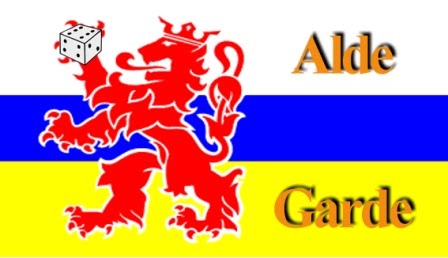Although in the last post I already showed some known colonels flag, I think it is good to give some background to organisation and flags of the Dutch infantry.
In 1752 (after the War of the Austrian Succession or WAS) the Dutch infantry was reorganised by uniting 2 1-battlion strong regiments into one regiment or disbanding regiments.
The National, German and Scottish infantry had the same organisation with two battalion each of 6 musketeer and one grenadier company.
The Walloon regiment was the only one which up to around 1790 had 3 battalions but with the same amount of companies per battalion.
The Scottish regiments became in 1783 national regiments but kept its organisation.
The Swiss regiments were different:
- The Swiss guard had 4 companies per battalion
- The Swiss line regiments had 6 companies per battalion.
Both had about 10 grenadiers incorporated into each company and didn't have a seperate genadiercompany. It is possible and likely, that in the field the grenadiers were combined into a seperate unit or company.
As units were combined or disbanded in 1752 I think at that time most new regiments received new flags although the first time they would carry the older flags until replaced
Most of the regiments would have two flags per battalion which probably was one colonels and three regimentals but up to now I haven't find a definitieve proof of that. So maybe each battalion had one colonels and one regimental flag.
The Swiss had 4 (guard) or six (line) flags per battalion which probably resulted in one colonel and seven regimental flags (guard) or one colonel and eleven regimental flags (line). It is not known if the Swiss regiments had all their flags with them when on campaign in the 1793-1795 period.
Regarding the flags themselves:
Colonels flags
- The colonelsflag were probably in white but the existing flags (in the Rijksmuseum Amsterdam) are now in an offwhite (called ecrú) colour.
The wexisting flags measure about one meter square.
The flags shows:
x- mostly the coat of arms of the province who paid for the regiment. In this case the provincial coat of arms was placed on a field of trophies as flags, canons, weapons etc.
x- sometimes the coat of arms of the Republic itself (this could be on the back of a colonels colour as is known by the flag of the province of Overijssel
x- the Orange related (eg Orange Friesland regiment) or Hollandse garde regiments probably all had heraldic signs of the Orange family on the colonels flag
x-and probably some colonels flag had the coat of arms of the (country of the) proprietor eg in the German regiments
As said, the flag could have two identical sides but also known is the Overijssel flag with one side the coat of arms of Overijssel and on the back the coat of arms of the Republic.
Of some provinces, the flags are known and were portrayed in the previous blogpost but other are not known.
Regimental flags
- The regimental flag(s) were coloured and bore probably the coat of arms of the proprietor. In the case in which the Stadholder was the proprietor, this regimental was orange as is shown on pictures of the flag of the Hollandse Garde.
No flags of National Regiments exists anymore and only some of Orange regiments and of German regiments. So only you can make an educated guess how the flas would have looked. Someday my interpetration will be published here.
Flags of Swiss regiments
These have a different history to the Dutch and look different; they have their own kind of colonels flag (but all in white) and as regimental flag the well known flag with multicoloured flames.
I have pictures of most of these colour from various sources so these will appear here sometime if I find the time.
Flags of hired units
This means eg French emigré units (no flags known yet) and German hired troops (some known).
If available, these will appear here sometime.

No comments:
Post a Comment